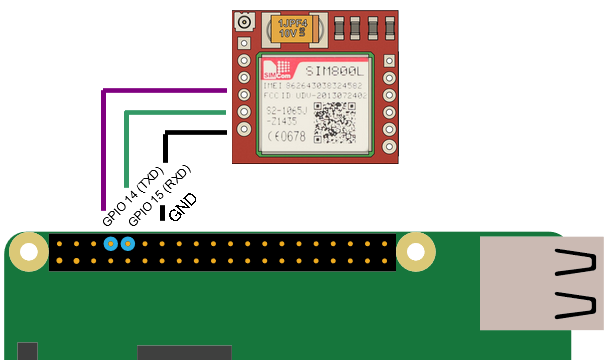NOTICE: Be prepared to handle huge power consumption with peek up to 2A. Maximum voltage on UART in this module is 2.8V. Higher voltage will kill the module.Pinout SIM800L
SIM800L is a complete Quad-band GSM/GPRS solution in a SMT type which can be embedded in the customer applications.
SIM800L support Quad-band 850/900/1800/1900MHz, it can transmit Voice, SMS and data information with low power consumption. With tiny size of 15.8*17.8*2.4 mm, it can fit into slim and compact demands of customer design. Featuring Bluetooth and Embedded AT, it allows total cost savings and fast time-to-market for customer applications.
PinoutRaspberryPi
The Raspberry Pi is a low cost, credit-card sized computer that plugs into a computer monitor or TV, and uses a standard keyboard and mouse. It is a capable little device that enables people of all ages to explore computing, and to learn how to program in languages like Scratch and Python. It’s capable of doing everything you’d expect a desktop computer to do, from browsing the internet and playing high-definition video, to making spreadsheets, word-processing, and playing games.
USSD (Unstructured Supplementary Service Data) is an interactive, menu-based technology communication protocol available on every GSM-enabled mobile device.
It is a session-based text communication without a store-and-forward mechanism (unlike SMS) that is practical for interactive communication, such as banking or education.
USSD messages can have up to 182 alphanumeric characters and the time it takes from a request to a response is 2 seconds while it takes 6 seconds for an SMS to reach a mobile phone.
What is the difference between USSD and SMS?While SMS is a store and forward technology, USSD texts and interactions are not stored on the mobile phone. SMS content remains stored in the mobile phone memory.
Examples of USSD usageSome examples of service usage are airtime top-ups, "please call me" services, balance checking and mini statements delivery.
What about USSD short codes?USSD short code format is defined by the * and # signs at the beginning and the end of the series of digits.
There are three types of USSD short codes available. The standard rate USSD short code is charged the standard fee for the USSD menu usage by the end-user. Reverse-billed short codes are free for the end-user. Premium rate USSD short codes are charging the end user a premium price for short code triggering. Generally, USSD short codes are either reverse-billed or standard rate.
RequirementsPython 2.7 or Python 3.4 and newerIf running on Windows: Windows 7 or newer
This installs a package that can be used from Python:
import serialpySerial can be installed from PyPI:
python -m pip install pyserial
Using the python/python3 executable of the desired version (2.7/3.x).
Developers also may be interested to get the source archive, because it
contains examples, tests and the this documentation. By using PyPI, you will be using the latest stable version.
Useful links- AT Commands
- Hardware Design
- Specification
- 3D Adapter Board
- Tutorial Arduino
- Arduino Library
- PySerial
- PySerial Git
print('If this project help you, you can give me a tip ;) ')Paypal/mamdpay<<<<<<<<<<<>>>>>>>>>>>Linkedin/MortadhaDahmani












_3u05Tpwasz.png?auto=compress%2Cformat&w=40&h=40&fit=fillmax&bg=fff&dpr=2)
Comments
Please log in or sign up to comment.